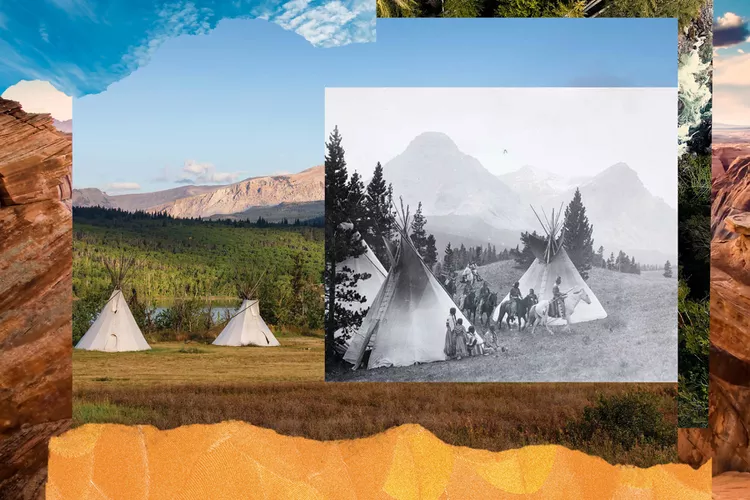Summary
We’re reflecting on the significance of Native lands in the past, present, and future, and learning how to be mindful visitors in these places, at home and on vacation.
Fact checked by
Jillian Dara
No matter where you travel in the United States (and more widely, North America), you’re visiting the ancestral territories of Indigenous people.
At its most meaningful, travel can be an educational tool that deepens our understanding and respect for places, cultures, and people different from our own. Whether you travel across the United States or stick to your hometown, visit big cities or one of the country’s national parks, make an effort to learn about your destination’s first inhabitants.
The narrative surrounding our country’s wide-open spaces too often overlooks the true human history of these lands; there’s much more to the story of these places and their people. So, with expert guidance, we’ve gathered some informative tips for visiting Native land.
Learn about the land
Indigenous land acknowledgements have become increasingly popular in recent years, serving as a good starting point, especially when traveling to a new location. A land acknowledgement is a statement that recognizes the Indigenous people who first inhabited the area you’re visiting and their ongoing connection to that land, honoring their stewardship and acknowledging the continuous effects of colonialism. Before you can perform a land acknowledgement, you’ll need to learn more about the land you’re on.
Native Land Digital, an Indigenous-led Canadian nonprofit, is an excellent resource. The website features a continuously evolving, searchable map to identify which Indigenous nations and communities are tied to the land. Christine McRae, executive director at Native Land Digital, emphasizes that when traveling, it’s important to explore the Indigenous knowledge of that area, including its name in Indigenous languages and significant historical events. She states, “We have this responsibility to push deeper to learn about the full stories of the place” as colonial narratives often fail to convey the extensive history encompassing thousands of years. Additionally, she notes, “We have a responsibility to educate ourselves about whose land we’re on and who we can connect with.”
Be a respectful visitor
Basic travel etiquette applies when visiting public parklands—whether they are national, state, or local. Always stay on marked trails, dispose of trash properly, refrain from vandalizing, keep a safe distance from wildlife, and be considerate of other visitors. If you enter tribal lands, such as reservations, recognize that you are in a residential community with specific customs and regulations—what may be acceptable in one reservation might not be allowed in another, and some experiences may be closed to the public. Generally, you should always ask for permission before photographing people or cultural practices, and avoid taking any objects you encounter on these lands. Varela suggests treating these spaces with the same respect and consideration that you would expect from visitors to your home.
Visit the local cultural center
Consider visiting Indigenous cultural centers and museums to deepen your understanding of the area’s history, culture, and community. These venues often showcase a range of experiences and exhibits, enabling exploration of tribal traditions through artifacts, replications of historic homes, storytelling by tribal members, traditional attire and crafts, educational discussions, performances, and even hands-on workshops. Bill Wright, superintendent of Chickasaw National Recreation Area, notes that while each national park has its own uniqueness, it is critical to educate the public about its history and encourage visitors to explore locations such as the Chickasaw Visitor Center and Cultural Center.
Support Indigenous-owned businesses
Supporting Indigenous-owned businesses is an impactful way to contribute to these communities. Research local restaurants, shops, hotels, and tour companies owned by Native individuals and nations in your travel area. By choosing to patronize these businesses, you will gain a richer understanding of the history and culture of the place you are visiting. Indigenous-owned restaurants offer unique local culinary experiences; shops may feature authentic arts and crafts; Native tour guides can provide invaluable insights about the landscape you’re exploring. McRae emphasizes that it’s important to “seek out tourist attractions, accommodations, and experiences managed by Indigenous people to achieve a fuller understanding of the place you’re visiting.”
Continue to educate yourself, even after your trip
Your journey of learning doesn’t have to conclude upon returning home. You can explore the land that you call home, investigate local cultural centers to learn more about its first inhabitants, and continue to support Indigenous-owned businesses. Follow Indigenous creators across social media platforms as they share valuable information and resources. Tune into Indigenous news outlets or accounts that raise awareness about the issues facing Native peoples—these critical topics often receive inadequate attention, so engaging with Indigenous-led organizations and activists is imperative (and sharing this knowledge with others is equally significant). As you enhance your understanding, discover ways to support these communities, whether by donating to organizations aiding Native peoples or directly to nations through their official websites.
Elizabeth Rhodes is an associate digital editor at GoTravelDaily and a member of the Nansemond Indian Nation. Follow her adventures on Instagram @elizabetheverywhere.
Program Credits
Editorial Lead: Alisha Prakash and Elizabeth Rhodes
Contributors: Johanna Read, Carrie Ann Back, Elizabeth Rhodes
Visuals Editor: Mariah Tyler
Creative Director: Jenna Brillhart
Art Director: Sarah Maiden
Producer: Karen Chen





